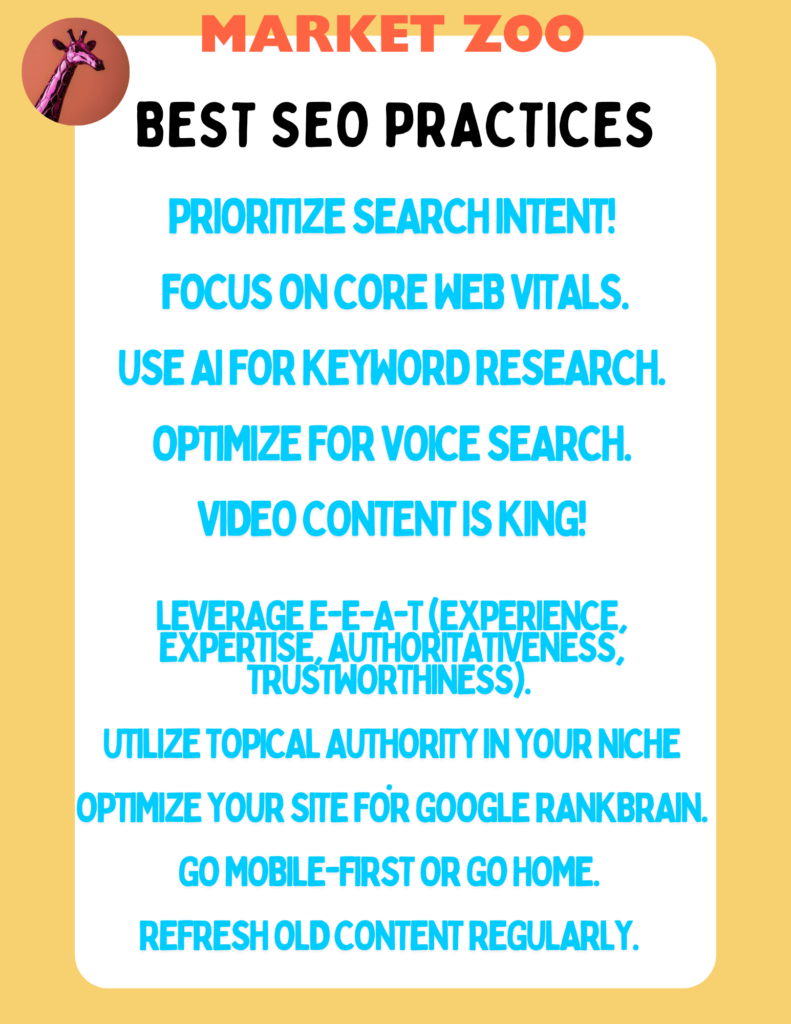
1. Prioritize Search Intent! 🎯
Explanation: In 2024, aligning your content with the user’s search intent (informational, transactional, or navigational) is key to higher rankings. Search engines are smarter at understanding what people actually want.
Example: If someone searches for “best running shoes for marathon training,” they’re looking for product comparisons, not a general article on running shoes.
Pro Tip: Map search intent to each keyword. Tools like Google Search Console can help you identify which keywords lead to higher engagement(HubSpot Blog)(WordStream).
2. Focus on Core Web Vitals. 🚀
Explanation: Google’s Core Web Vitals measure page speed, responsiveness, and visual stability. Slow sites = bad SEO.
Example: Amazon increased its revenue by 1% for every 100 milliseconds of improvement in load times.
Pro Tip: Use Google’s PageSpeed Insights to check and optimize for key metrics like Largest Contentful Paint (LCP), First Input Delay (FID), and Cumulative Layout Shift (CLS)(HubSpot Blog)(Backlinko).
3. Use AI for Keyword Research. 🤖
Explanation: AI tools like ChatGPT and Semrush’s AI-powered keyword tools can analyze vast datasets to find untapped keywords quicker than traditional methods.
Example: AI can suggest long-tail keywords based on trends in real-time, helping you stay ahead of your competitors.
Pro Tip: Use AI for keyword clustering and intent prediction to prioritize high-converting terms(Backlinko)(Semrush).
4. Optimize for Voice Search. 🎙️
Explanation: With the rise of smart speakers and virtual assistants, voice searches are becoming more conversational.
Example: Queries like “How to fix a leaky faucet?” will perform better if your content answers in a conversational tone.
Pro Tip: Use question-based keywords and ensure content is scannable. Focus on featured snippets to capture voice-search results(WordStream)(Semrush).
5. Video Content is King! 🎥
Explanation: Videos drive more engagement and visibility, as Google continues to prioritize video results on SERPs.
Example: 82% of internet traffic comes from video content in 2024. Platforms like YouTube SEO are crucial for boosting your visibility.
Pro Tip: Add transcripts, descriptive tags, and engaging thumbnails to your videos for maximum SEO impact(WordStream)(Backlinko).
6. Leverage E-E-A-T (Experience, Expertise, Authoritativeness, Trustworthiness). 🏆
Explanation: Google places a premium on content creators who demonstrate experience and authority in their niche.
Example: Medical websites like Mayo Clinic rank highly because of the trust they’ve built with well-researched, expert content.
Pro Tip: Boost your E-E-A-T by collaborating with industry experts and linking to credible sources. Display author bios to highlight credentials(HubSpot Blog)(WordStream).
7. Utilize Topical Authority in Your Niche. 📚
Explanation: Establishing topical authority means covering a subject thoroughly with high-quality, interconnected content pieces.
Example: A blog on gardening might cover everything from plant care to soil types, building a web of related content that makes Google see it as an authority.
Pro Tip: Use topic clusters to cover all subtopics. Include internal linking to improve navigation and showcase your content depth(Semrush)(Backlinko).
8. Optimize Your Site for Google RankBrain. 🧠
Explanation: RankBrain, Google’s AI algorithm, evaluates how users interact with your content (click-through rates, time on page).
Example: If users spend more time on your page and engage with it, RankBrain boosts your rankings.
Pro Tip: Improve user experience by making your content engaging and interactive (videos, quizzes, etc.) to keep visitors on your page longer(Backlinko)(Semrush).
9. Go Mobile-First or Go Home. 📱
Explanation: With more than 50% of searches coming from mobile devices, mobile-first indexing means Google ranks the mobile version of your site before desktop.
Example: Google penalizes websites that don’t perform well on mobile with lower rankings, so ensure your site is responsive and fast.
Pro Tip: Test your site on mobile devices using Google’s Mobile-Friendly Test tool and minimize pop-ups that interrupt the user experience(Semrush)(HubSpot Blog)
10. Refresh Old Content Regularly. 🔄
Explanation: Fresh, up-to-date content is favored by Google’s ranking algorithm. Regularly updating old content with relevant information helps maintain or boost rankings and attracts fresh traffic to your site.
Example: Updating blog posts with new statistics, updated insights, and internal links can breathe new life into older posts. For instance, a blog post on “Top SEO Trends of 2022” can be refreshed with insights for 2024 and new case studies or examples.
Pro Tip: Add new media (images, infographics, or videos) and repurpose the content for different formats like podcasts or eBooks. This signals to Google that the content is relevant and up-to-date, boosting your rankings(WordStream)(Semrush)(Backlinko).

